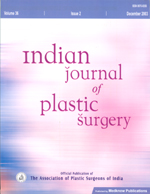
|
Indian Journal of Plastic Surgery
Medknow Publications on behalf of Indian Journal of Plastic Surgery
ISSN: 0970-0358
EISSN: 0970-0358
Vol. 39, No. 1, 2006, pp. 42-50
|
 Bioline Code: pl06010
Bioline Code: pl06010
Full paper language: English
Document type: Research Article
Document available free of charge
|
|
|
Indian Journal of Plastic Surgery, Vol. 39, No. 1, 2006, pp. 42-50
| en |
A scanning electron microscopic evaluation of microsurgical anastomosis by conventional end to end and end to end anastomosis using "temporary stent" technique: An experimental study
Chaware SureshM, Bhatnagar SK, Singh AK
Abstract
Background: The art of microvascular repair progressed slowly over a century after Carrel's original description of 'vascular repair' in 1902. Reports of the successful repair of vessels smaller than one mm in diameter are currently commonplace. However, the art of microvascular surgery has not yet been perfected, as evidenced by frequent reports of clinical failure. This study was undertaken to determine the effect of a 'temporary stent' on the patency rates of vessels and to study the vascular endothelium under electron microscope to determine the changes caused by both conventional and the experimental technique.
Materials and Methods: This study consisted of two distinct arms. In the first part (27 rats) we studied the effect of temporary stenting on end to end anastomosis vis a vis its patency rates. While in the second part (30 rats) the same experiment was performed with a view to examine the anastomosis under electron microscope at different time frames to study the state of the endothelium in the vessel lumen at the site of anastomosis and also along the length of the vessel up to the point where clamps were applied.
Results: In our study conventional end-to-end microvascular anastomoses had late patency rate of 70.37%. While end-to-end microvascular anastomoses using temporary stent had patency rate of 92.59%. On electron microscopic study, it was observed that, the endothelial damage was less in the stented group.
Conclusion: Stent technique produces lesser degree of trauma to the vessel and no serious complications compared to the conventional dilatation and manipulation with vessel dilator.
Keywords
Anastomoses, end to end temporary stent, microsurgical anastomosis
|
| |
© Copyright 2006 Indian Journal of Plastic Surgery.
Alternative site location: http://www.ijps.org/
|
|
